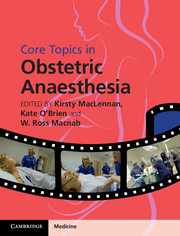Book contents
- Frontmatter
- Contents
- List of contributors
- Preface
- Section 1 Basic science, epidemiology and service organization
- Section 2 Obstetric aspects
- Section 3 Provision of anaesthesia
- Section 4 Medical conditions in pregnancy
- Section 5 Postpartum complications and obstetric emergencies
- Section 6 Service organization
- 27 Multidisciplinary teaching and training on the delivery unit
- 28 Clinical governance and patient safety
- 29 Ethics, consent and the law
- Index
- Plate section
- References
27 - Multidisciplinary teaching and training on the delivery unit
from Section 6 - Service organization
Published online by Cambridge University Press: 05 December 2015
- Frontmatter
- Contents
- List of contributors
- Preface
- Section 1 Basic science, epidemiology and service organization
- Section 2 Obstetric aspects
- Section 3 Provision of anaesthesia
- Section 4 Medical conditions in pregnancy
- Section 5 Postpartum complications and obstetric emergencies
- Section 6 Service organization
- 27 Multidisciplinary teaching and training on the delivery unit
- 28 Clinical governance and patient safety
- 29 Ethics, consent and the law
- Index
- Plate section
- References
Summary
Introduction
In addition to the central role of training anaesthetic trainees in obstetric anaesthesia, working on the delivery unit presents many opportunities for the anaesthetist to become involved in education of the multidisciplinary team. Areas of education particularly pertinent to the skills and expertise of anaesthetists are:
• Training midwives and junior doctors in delivering critical care on the delivery unit and recognition and management of the sick parturient
• Skills/drills or simulation team training for emergencies on the delivery unit
• ‘Pain relief for childbirth’ education for midwives, including regional analgesia/anaesthesia.
One of the main challenges in education provision on the delivery unit is the ability to allocate adequate time for staff, away from clinical duties, to attend training. It is known that when units are busy and understaffed, staff are unable to take up scheduled teaching sessions. Anaesthetists should help champion education needs at management level and also consider strategies to deliver education in novel ways that can be accessed more flexibly, for example, with e-learning packages or video podcasts of lectures.
Education on the sick parturient
Care of the sick parturient on the obstetric unit has been closely examined in recent years. Recurrent themes in the triennial reports from the Centre for Maternal and Child Enquiries (CMACE) have included:
• Late recognition by midwifery and medical staff of the seriously unwell woman
• Inadequate and infrequent performance of basic observations
• Inappropriate or no action taken in women found to have abnormal observations.
Obstetric anaesthetists should be prominent in the education of midwives and junior doctors in the recognition and management of the critically ill obstetric patient.
Midwives must be able to accurately measure and record observations, recognize when they are abnormal and alert the appropriate staff. Many midwives now qualify after a direct-entry degree course and often have had no prior general nursing exposure. While skilled in many areas of parturient management, they often lack the experience of caring for sick medical or surgical patients, and may have an incomplete understanding of the relevance of abnormal physiological observations. The current undergraduate midwifery courses focus mainly on well women, with less emphasis on sick patients or those with pre-existing medical conditions. Future curriculum development within undergraduate midwifery training should aim to address this.
- Type
- Chapter
- Information
- Core Topics in Obstetric Anaesthesia , pp. 211 - 218Publisher: Cambridge University PressPrint publication year: 2015



